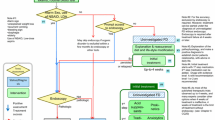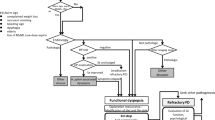Abstract
Optimal therapy for patients with non-ulcer dyspepsia still remains elusive. Increasing consensus on the definition of non-ulcer dyspepsia may improve the design of clinical trials and result in more effective therapies for this common condition. This paper reviews the investigation, pathophysiology and therapy of non-ulcer dyspepsia in order to formulate management strategies in the elderly.
The best outcome for the patient can be achieved by detailed evaluation, leading to therapy targeted to obvious precipitating factors such as dyspepsia-inducing medications and other aggravating factors such as slow-transit constipation. Pro-kinetics and, to a lesser extent, H2 receptor antagonists are the main medications of choice. Cisapride, the best studied prokinetic, has been withdrawn from the market in certain countries because some patients experienced dangerous cardiac arrhythmias, especially when cisapride was given with potent inhibitors of cytochrome P450 3A4. Time spent on reassurance and judicious use of antidepressants for the right patient can help improve symptoms. In the elderly, however, persistent symptoms should be re-evaluated because of the increased incidence of malignancy.

Similar content being viewed by others
References
Jones R, Lydeard S, Hobbs F, et al. Dyspepsia in England and Scotland. Gut 1990; 31: 401–5
Penston J, Pounder R. A survey of dyspepsia in Great Britain. Aliment Pharmacol Ther 1996; 10: 83–9
Talley NJ. A critique of therapeutic trials in Helicobacter pylori positive functional dyspepsia. Gastroenterology 1996; 106: 1174–83
Jones R. Gastrointestinal problems in general practice. Oxford: Oxford University Press, 1993
Office of Health Economics. OHE compendium of health statistics. 8th ed. London: Office of Health Economics, 1992
Colin-Jones D. Management of dyspepsia: report of a working party. Lancet 1987; I: 576–8
Kaul B, Halvorsen T, Petersen H, et al. Gastroesophageal reflux disease. Scintigraphic, endoscopic and histologic considerations. Scand J Gastroenterol 1986; 21(2): 134–8
Johnston BT, Collins JS, McFarland RJ, et al. Are esophageal symptoms reflux-related?. A study of different scoring systems in a cohort of patients with heartburn. Am J Gastroenterol 1994; 89(4): 497–502
Talley NJ, Stanghellini V, Heading RC, et al. Functional gastroduodenal disorders. Gut 1999; 45Suppl. 2: 37–42
Knill JR. Geographical differences in the prevalence of dyspepsia. Scand J Gastroenterol Suppl 1991; 182(17): 17–24
Richter JE. Dyspepsia: organic causes and differential characteristics from functional dyspepsia. Scand J Gastroenterol Suppl 1991; 182(17): 11–6
Williams B, Luckas M, Ellingham JH, et al. Do young patients with dyspepsia need investigation? Lancet 1988; II: 1349–51
Gear MWL, Wilkinson SP. Open-access upper alimentary endoscopy. Br J Hosp Med 1989; 41: 438–44
Sobala GM, Crabtree JE, Pentith JA, et al. Screening dyspepsia by serology to Helicobacter pylori. Lancet 1991; 338: 94–6
Heikkinen M, Pikkarainen P, Takala J, et al. Etiology of dyspepsia: four hundred unselected consecutive patients in general practice. Scand J Gastroenterol 1995; 30: 519–23
Heikkinen M, Pikkarainen P, Takala J, et al. Diagnostic methods in dyspepsia: the usefulness of upper abdominal ultrasound and gastroscopy. Scand J Prim Health Care 1997; 15: 82–6
Talley NJ, Evans JM, Fleming KC, et al. Nonsteroidal anti-inflammatory drugs and dyspepsia in the elderly. Dig Dis Sci 1995; 40: 1345–50
Jones RH, Tait CL. Gastrointestinal side-effects of NSAIDs in the community. Br J Clin Pract 1995; 49: 67–70
Talley NJ, Zinsmeister AR, Schleck CD, et al. Dyspepsia and dyspepsia subgroups: a population-based study. Gastroenterology 1992; 102: 1259–68
Malagelada JR, Stanghellini V. Manometric evaluation of functional upper gut symptoms. Gastroenterology 1985; 88: 1223–31
Waldron B, Cullen PT, Kumar R, et al. Evidence for hypomotility in non-ulcer dyspepsia: a prospective multifactorial study. Gut 1991; 32: 246–51
Caballero-Plasencia AM, Muros-Navarro MC, Martin-Ruiz JLV, et al. Gastroparesis of digestible and indigestible solids in patients with insulin-dependent diabetes mellitus or functional dyspepsia. Dig Dis Sci 1994; 39: 1409–15
Jian R, Ducrot F, Ruskone A, et al. Symptomatic, radionuclide and therapeutic assessment of chronic idiopathic dyspepsia. A double-blind placebo-controlled evaluation of cisapride. Dig Dis Sci 1989; 34: 657–64
Stanghellini V, Tosetti C, Paternicö A, et al. Risk indicators of delayed gastric emptying of solids in patients with functional dyspepsia. Gastroenterology 1996; 110: 1036–42
Tack J, Piessevaux H, Coulie B, et al. Role of impaired gastric accommodation to a meal in functional dyspepsia. Gastroenterology 1998; 115: 1346–52
Lemann M, Dederding JP, Flourie B, et al. Abnormal perception of visceral pain in response to gastric distension in chronic idiopathic dyspepsia. The irritable stomach syndrome. Dig Dis Sci 1991; 36: 1249–54
Mertz H, Fullerton S, Naliboff B, et al. Symptoms and visceral perception in severe functional and organic dyspepsia. Gut 1998; 42: 814–22
Samsom M, Verhagen MA, vanBerge Henegouwen GP, et al. Abnormal clearance of exogenous acid and increased acid sensitivity of the proximal duodenum in dyspeptic patients. Gastroenterology 1999; 116: 515–20
Mearin F, Cucala M, Azpiroz F, et al. The origin of symptoms on the brain-gut axis in functional dyspepsia. Gastroenterology 1991; 101: 999–1006
Kane Jr FJ, Strohlein J, Harper RG. Nonulcer dyspepsia associated with psychiatric disorder. South Med J 1993; 86: 641–6
Lydeard S, Jones R. Factors affecting the decision to consult with dyspepsia: comparison of consulters and non-consulters. J Roy Coll Gen Pract 1989; 39: 495–8
Bytzer P, Hansen JM, Schaffalitzky de Muckadell OB. Empirical H2-blocker therapy or prompt endoscopy in management of dyspepsia. Lancet 1994; 343: 811–6
Malagelada JR. Functional dyspepsia. Insights on mechanisms and management strategies. Gastroenterol Clin North Am 1996; 25(1): 103–12
Haug TT, Wilhelmsen I, Svebak S, et al. Psychotherapy in functional dyspepsia. J Psychosom Res 1994; 38: 735–44
Marshall BJ, Goodwin CS, Warren JR, et al. Prospective double-blind trial of duodenal ulcer relapse after eradication of Campylobacter pylori. Lancet 1988; II: 1437–42
Rauws EA, Tytgat GN. Cure of duodenal ulcer associated with eradication of Helicobacter pylori. Lancet 1990; 335: 1233–5
Helicobacter pylori in peptic ulcer disease. National Institute of Health (NIH) Consensus Conference. JAMA 1994; 272: 65–9
Lambert JR. The role of Helicobacter pylori in nonulcer dyspepsia. A debate for. Gastroenterol Clin North Am 1993; 22: 141–51
Wilhelmsen I, Tangen Haug T, Sipponen P, et al. Helicobacter pylori in functional dyspepsia and normal controls. Scand J Gastroenterol 1994; 29: 522–7
Verdu EF, Fraser R, Tiberio D, et al. Prevalence of Helicobacter pylori infection and chronic dyspeptic symptoms among immigrants from developing countries and people born in industrialized countries. Digestion 1996; 57: 180–5
McColl K, Murray L, El-Omar E, et al. Symptomatic benefit from eradicating Helicobacter pylori infection in patients with nonulcer dyspepsia. N Engl J Med 1998; 339: 1869–74
Talley NJ, Vakil N, Ballard ED, et al. Absence of benefit of eradicating Helicobacter pylori in patients with nonulcer dyspepsia. N Engl J Med 1999; 341: 1106–11
Blum AL, Talley NJ, van Zanten SV, et al. Lack of effect of treating Helicobacter pylori infection in patients with nonulcer dyspepsia. Omeprazole plus Clarithromycin and Amoxicillin Effect One Year after Treatment (OCAY) Study Group. N Engl J Med 1998; 339(26): 1875–81
Jaakkimainen RL, Boyle E, Tudiver F. Is Helicobacter pylori associated with non-ulcer dyspepsia and will eradication improve symptoms?. A meta-analysis. BMJ 1999; 319(7216): 1040–4
Moayyedi P, Soo S, Deeks J, et al. Systematic review and economic evaluation of Helicobacter pylori eradication treatment for non-ulcer dyspepsia. BMJ 2000; 321: 659–64
Gotthard R, Bodemar G, Brodin U, et al. Treatment with cimetidine, antacid, or placebo in patients with dyspepsia of unknown origin. Scand J Gastroenterol 1988; 23: 7–18
Kelbaek H, Linde J, Eriksen J, et al. Controlled clinical trial of treatment with cimetidine for non-ulcer dyspepsia. Acta Med Scand 1985; 217: 281–7
Nesland AA, Berstad A. Effect of cimetidine in patients with non-ulcer dyspepsia and erosive prepyloric changes. Scand J Gastroenterol 1985; 20: 629–5
Singal AK, Kumar A, Broor SL. Cimetidine in the treatment of non-ulcer dyspepsia: results of a randomized double-blind, placebo-controlled study. Curr Med Res Opin 1989; 11: 390–7
Saunders JH, Oliver RJ, Higson DL. Dyspepsia: incidence of a non-ulcer disease in a controlled trial of ranitidine in general practice. BMJ Clin Res Ed 1986; 292: 665–8
Soo S, Moayyedi P, Deeks J, et al. Pharmacological interventions for non-ulcer dyspepsia. The Cochrane Database of Systematic Reviews. Available in The Cochrane Library [database on disk and CD ROM]. Updated quarterly. The Cochrane Collection; issue 4. Oxford: Update Software, 2000
Chung JM. Cisapride in chronic dyspepsia: results of a double-blind, placebo-controlled trial [published erratum appears in Scand J Gastroenterol Suppl 1993 Sep; 28 (9): following 749]. Scand J Gastroenterol Suppl 1993; 195: 11–4
Kellow JE, Cowan H, Shuter B, et al. Efficacy of cisapride therapy in functional dyspepsia. Alimen Pharmacol Ther 1995; 9: 153–60
Yeoh KG, Kang JY, Tay HH, et al. Effect of cisapride on functional dyspepsia in patients with and without histological gastritis: a double-blind placebo-controlled trial. J Gastroenterol Hepatol 1997; 12(1): 13–8
al-Quorain A, Larbi EB, al-Shedoki F. A double-blind, randomized, placebo-controlled trial of cisapride in Saudi Arabs with functional dyspepsia. Scand J Gastroenterol 1995; 30: 531–4
Thomas AR, Chan LN, Bauman JL, et al. Prolongation of the QT interval related to cisapride-diltiazem interaction. Pharmacotherapy 1998; 18(2): 381–5
Gray VS. Syncopal episodes associated with cisapride and concurrent drugs. Ann Pharmacother 1998; 32(6): 648–51
Piquette RK. Torsade de pointes induced by cisapride/clarithromycin interaction. Ann Pharmacother 1999; 33(1): 22–6
Walker AM, Szneke P, Weatherby LB, et al. The risk of serious cardiac arrhythmias among cisapride users in the United Kingdom and Canada. Am J Med 1999; 107(4): 356–62
Bekhti A, Rutgeerts L. Domperidone in the treatment of functional dyspepsia in patients with delayed gastric emptying. Postgrad Med J 1979; 55Suppl. 1: 30–2
Talley NJ, Meineche-Schmidt V, Pare P, et al. Efficacy of omeprazole in functional dyspepsia: double-blind, randomized, placebo-controlled trials (the Bond and Opera studies). Aliment Pharmacol Ther 1998; 12(11): 1055–65
Holtmann G, Gschossmann J, Karaus M, et al. Randomised double-blind comparison of simethicone with cisapride in functional dyspepsia. Aliment Pharmacol Ther 1999; 13(11): 1459–65
Mertz H, Fass R, Kodner A, et al. Effect of amitriptyline on symptoms, sleep, and visceral perception in patients with functional dyspepsia. Am J Gastroenterol 1998; 93(2): 160–5
Tanum L, Malt UF. A new pharmacologic treatment of functional gastrointestinal disorder. A double-blind placebo-controlled study with mianserin. Scand J Gastroenterol 1996; 31: 318–25
Hawkey CJ. Gastroduodenal problems associated with nonsteroidal, anti-inflammatory drugs (NSAIDs). Scand J Gastroenterol Suppl 1993; 200: 94–5
British National Formulatory, Section 4.3.1. London: British Medical Association, 2001 Mar
British National Formulatory, Section 4.3.3. London: British Medical Association, 2001 Mar
British National Formulatory, Section 4.6. London: British Medical Association, 2001 Mar
Bassotti G, Stanghellini V, Chiarioni G, et al. Upper gastrointestinal motor activity in patients with slow-transit constipation. Further evidence for an enteric neuropathy. Dig Dis Sci 1996; 41(10): 1999–2005
Acknowledgements
No funding was used to assist in the preparation of this manuscript. The author has no potential conflicts of interest that are directly relevant to the contents of this manuscript.
Author information
Authors and Affiliations
Corresponding author
Rights and permissions
About this article
Cite this article
Asante, M.A. Optimal Management of Patients With Non-Ulcer Dyspepsia. Drugs Aging 18, 819–826 (2001). https://doi.org/10.2165/00002512-200118110-00003
Published:
Issue Date:
DOI: https://doi.org/10.2165/00002512-200118110-00003




